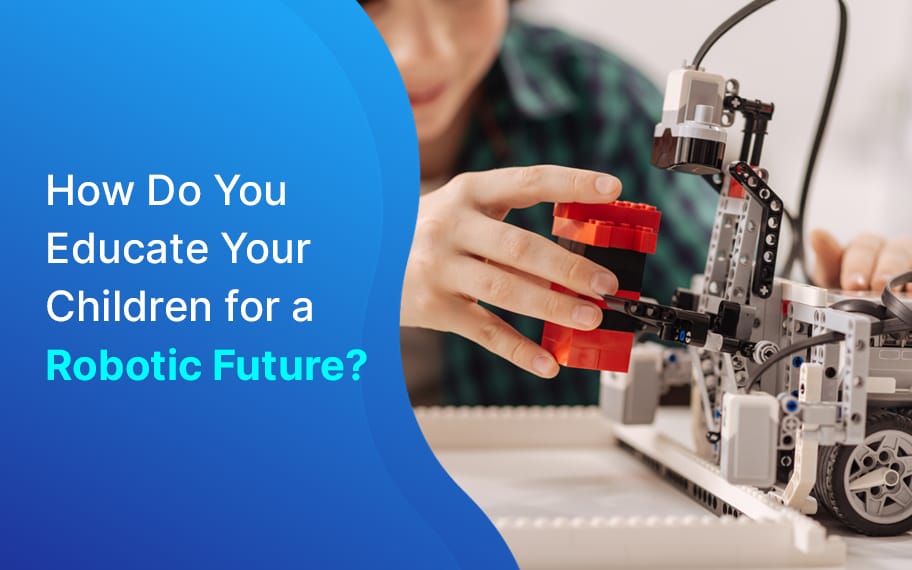It is now more crucial than ever to help our kids develop a lifelong curiosity and love of learning. Every day, we see the boundaries of technology pushing further. It's important to keep in mind Albert Einstein's statement, "I have no special talent." All I am is intensely inquisitive."
This emphasizes how important it is to consider including cutting-edge, thought-provoking skills like robotics in the curriculum for young students. Given the extensive use of robotics in practically every business, parents and educators are urged to recognize the value of robotics education for pupils. It is now more than simply an extracurricular activity—in order to prepare today's pupils for the future, it is a necessary learning experience! First, let's consider the following: what is robotics for children? This will also help us to comprehend the significance of robots.
What is Robotics for Kids?
Fundamentally, robotics is the study and manipulation of machines that can carry out tasks—much like the robots we see in movies and cartoons!
Over the next ten years, it is anticipated that the use of robotic kits would increase at a pace of 10.2% worldwide! Why? People now realize that pupils can thrive in a world full of robots if they help with robotics education!
Early childhood robotics offers several benefits. It's not only about building robots. According to a research, kids who attend robotics classes have:
exceptional academic achievement
Enhancement in their arithmetic abilities
Increased critical thinking, creativity, and problem-solving skills
Robotics knowledge is applied outside of the classroom as well. In a sense, the pupils are prepared for the tech-driven future in which technology will play a major role. These abilities may act as a springboard for creativity and lead to diverse career opportunities across a range of sectors.
Fascinating Applications of Robotics across Various Industries
- Medical: Robots help doctors in the operating room. Surgeons use robotics arm to conduct complex surgeries
- Astronomy: Robots can go to space to explore other planets and moons.
- Agriculture: They help with weed control, planting, harvesting, environmental monitoring and soil analysis.
- Construction: They help with labour-intensive tasks.
Numerous other uses exist. What matters more, though? Who is the robot designer?It's people with extensive robotics knowledge!
Why Robotics for Kids?
Unlike traditional education, which often depends on books and lectures, robotics education is fully hands-on. Young minds may build, test, and programme robots to carry out intriguing tasks by being introduced to this fascinating environment.
It's an engaging way to learn. It promotes originality and the ability to solve problems. Children are drawn to robotics and are given the opportunity to think like engineers. It gets students ready for a world where technology and creativity coexist in the future.
Getting Started with Robotics
Firstly, it is important for parents to recognise whether their child is inclined towards robotics. Check whether the child is
- Curious to know how gadgets work
- Intrigued to open and see what is inside the toys
- Inclined towards mobile phones
- Excited about seeing robots and tries to communicate with them
- Creative in their ideas
A child's interest in robotics is developed early on. In order for children to explore and experiment, parents and schools must first provide a conducive learning environment. Urge kids to be inquisitive and have a curiosity about robotics.
To take action, it's critical to find tools and materials that are suitable for young children. Schools need to work with companies that provide their pupils robotic education that is current and tailored to their standards.
Taking Robotics Classes to Experience Robotics Education in Action
The first step for everyone interested in technology is to sign up for robotics lessons. Experts in child education have shown that children should begin studying robotics between the ages of six and eight. Governments everywhere are pushing children to study robotics at a young age, realising its potential. Leading the globe in implementing policies to integrate robotics, coding, and other 21st-century skills into school curricula are the USA and China.
Beginning a journey via robotics education in action presents a plethora of options for enthusiastic young inventors. Students may design, build, and assemble their own robots via hands-on learning experiences in robotics classes and workshops. This fosters creativity, accelerates information processing, and fosters teamwork. These exercises aid in educating students about the value of robotics in our educational institutions.
But with the advent of course offerings, parents frequently ask, "Will my child face more pressure from learning robotics?"
Not at all. Kids often feel like they are playing with robots since robotics is a practical hobby. Not only does the fun and enjoyment relieve strain, but it also helps students appreciate studying!
In robotics classes, students study fascinating concepts ranging from understanding electronic components to programming robot actions. A student's interest in STEM education is piqued by the practical experience in today's tech-dependent culture.
Conclusion
The world is changing quite quickly these days. Should we not be preparing our children for a world where technology and robots rule?
We are aware that enhancing their 21st-century skills is difficult, but it is essential. Decisions taken now will pay off for future generations. The problems of the present and the future call for a more comprehensive viewpoint grounded in past knowledge and potential future developments.
By exposing youngsters to robotics, we are not just preparing our kids for the future but also actively shaping their curiosity, inventiveness, and essential abilities. By working together as leaders, educators, and parents, we can inspire the next generation of tech-savvy adults and further the positive advancement of this society!
Learn more about Teachmint plans here.












